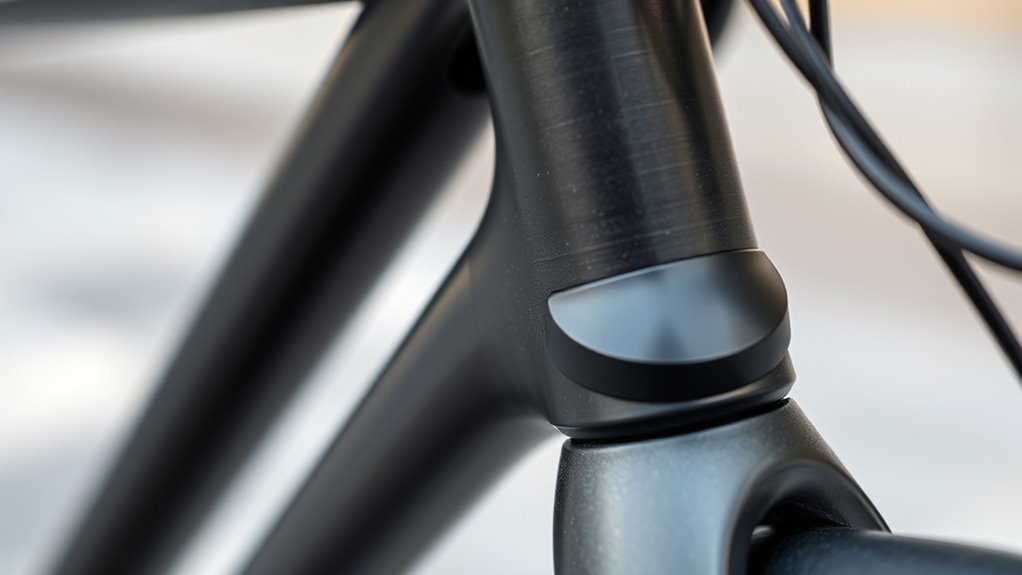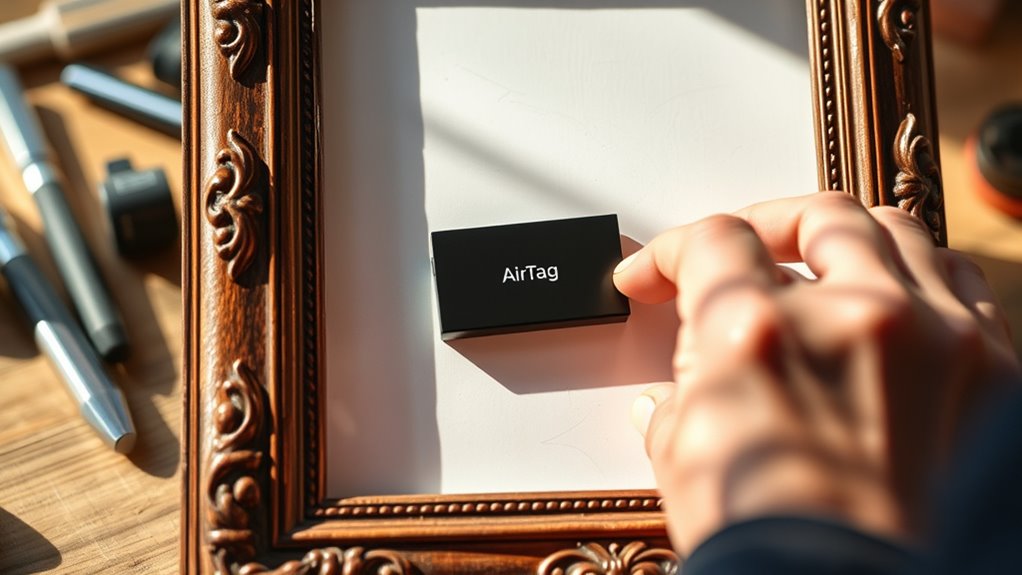Embedding an Airtag inside your bike frame can boost theft protection by hiding the tracker in a discreet location, making it harder for thieves to find. However, it requires careful installation to avoid damaging your bike or voiding warranties. While it offers long-term security, take into account potential risks like moisture exposure and legal privacy concerns. If you want to explore safe, effective ways to enhance your bike’s security, there’s more to consider beyond just placement.
Key Takeaways
- Embedding Airtags enhances theft security by making the tracker discreet and harder for thieves to locate.
- Proper installation inside the frame preserves bike aesthetics but requires careful planning to avoid damage.
- Hidden placement can prolong battery life and maintain optimal signal range, but risks frame damage if not done correctly.
- Installation complexity varies; inexperienced users may face challenges, and improper sealing could affect durability.
- Consider legal and privacy implications; ensure tracking is ethical and compliant with local laws before embedding a device.
Understanding How Airtags Work and Their Limitations
While Airtags are a convenient way to track your belongings, it’s important to understand how they work and their limitations. Airtags use Bluetooth technology to communicate with nearby Apple devices, which relay the location to you. Their signal range is typically up to 100 meters, but obstacles like walls can reduce this distance. The battery lifespan usually lasts about a year, depending on usage, and they have a replaceable battery. However, Airtags don’t have GPS, so they rely on your device network for location updates. This means their effectiveness diminishes in areas with few Apple devices. Understanding these factors helps you set realistic expectations and make informed decisions about using Airtags for tracking your bike or other valuables. Understanding industry trends can also help you stay updated on new features and improvements. Additionally, being aware of privacy considerations related to location sharing can help you protect your personal information. Recognizing the limitations of Bluetooth technology is essential for managing expectations regarding tracking accuracy and range. Furthermore, network density plays a crucial role in how effective Airtags are in locating your items in different environments.
Benefits of Embedding an Airtag Inside Your Bike Frame
Embedding an Airtag inside your bike frame greatly improves theft security by making your bike harder to steal unnoticed. It also provides discreet location tracking, so you can find your bike without alerting potential thieves. This simple upgrade offers peace of mind and enhanced protection for your ride. Incorporating smart home devices can further streamline your security measures and integrate your bike tracking into your overall lifestyle management. Additionally, choosing a high-quality waterproof planters can ensure your bike remains protected from the elements during outdoor storage. Leveraging automation technologies can enable you to monitor and control your security system remotely, adding another layer of protection. Staying informed about sneaker culture can inspire stylish ways to personalize your gear and accessories related to your outdoor activities.
Enhanced Theft Security
Embedding an Airtag inside your bike frame substantially boosts theft security by making it harder for thieves to locate and steal your bike without detection. With the Airtag hidden, a thief may struggle to find it quickly, especially if the signal range is limited, reducing the chance of a swift theft. The battery life of the Airtag ensures long-term tracking without frequent replacements, giving you peace of mind. Since the device relies on Bluetooth and the Find My network, it can be located even if the thief tries to hide it, as long as it’s within signal range or connected to other Apple devices. Additionally, embedding an Airtag enhances your bike’s security by making theft more difficult and increasing the chances of recovery. Understanding tracking limitations is essential for maximizing the effectiveness of your security measures. Awareness of signal range and how it influences tracking accuracy can help you optimize placement for better coverage. Moreover, knowing how to properly conceal the Airtag within the frame can further improve your security strategy. Proper placement near power sources or hidden compartments can also prolong the Airtag’s effectiveness and make it less detectable.
Discreet Location Tracking
Placing an Airtag inside your bike frame keeps its location discreet and protected from view, enhancing your bike security without drawing attention. This subtle placement prevents potential thieves from detecting the tracker easily, making it a smart choice for discreet location tracking. However, privacy concerns might arise if the Airtag’s signals are accessed without your consent. To balance security and privacy, ensure your Airtag is only accessible to trusted devices. Here’s a quick comparison:
| Benefit | Drawback | Best For |
|---|---|---|
| Hidden from view | Possible privacy concerns | Protecting high-value bikes |
| Reduces theft risk | Needs proper placement | Active tracking in real-time |
| Maintains aesthetics | Limited visibility for maintenance | Discreet bike security |
| Easy to monitor | Signal interference potential | Peace of mind |
| Keeps location private | Privacy settings necessary | Concealed location tracking |
Additionally, understanding the importance of essential oils and their benefits can help you maintain your bike’s condition and your personal well-being. For example, using natural lubricants can help keep your bike components functioning smoothly over time. Incorporating proper maintenance practices ensures your bike remains in optimal condition and prolongs its lifespan. Regularly checking and maintaining your bike parts, similar to rustic decor in a farmhouse bedroom, helps preserve the integrity and aesthetic appeal of your bicycle.
Potential Risks and Challenges of Installation

While installing an Airtag inside your bike frame can help keep track of your ride, it also introduces several risks and challenges. One major concern is aesthetic disruption; placing the Airtag may compromise the sleek look of your bike. Additionally, installation complexity can be high, especially if you lack experience with bike maintenance or electronics. You might risk damaging the frame or the Airtag if you’re not careful, which could lead to costly repairs or ineffective tracking. There’s also the chance that the Airtag shifts over time or becomes dislodged, reducing its reliability. Moreover, sealing the Airtag properly is essential to prevent moisture or dirt from affecting its performance, adding another layer of difficulty. An understanding of Fokos can help you better evaluate the durability of your installation options and prevent potential failures. Proper sealing techniques and durability considerations are crucial to ensure the Airtag remains functional over time. Additionally, considering vacuum cleaner performance metrics can inform you about the best methods and tools for secure installation, ensuring the Airtag stays in place. It’s also important to consider air purifier features, as they highlight the significance of selecting appropriate protective enclosures or sealants for electronic devices in challenging environments. Overall, these risks require careful consideration before proceeding.
Methods for Discreetly Installing an Airtag in Your Bike

To keep your Airtag hidden, consider using clever mounting techniques that blend with your bike’s design. You can also hide it inside frame components or behind existing panels to keep it discreet. These methods help protect your device while maintaining the bike’s sleek look. Additionally, choosing appropriate mounting locations that do not interfere with your bike’s operation ensures both safety and stealth.
Hidden Mounting Techniques
Discreetly installing an Airtag inside your bike requires creative mounting methods that keep the device hidden while remaining accessible when needed. To maintain aesthetic considerations, choose spots out of sight, like inside the seat post or behind the bottom bracket. Using small, custom mounts or adhesive pads can help conceal the Airtag effectively. Keep in mind that some locations may increase installation difficulty, especially if you need to modify components or drill holes. The goal is to balance stealth with ease of access for retrieval or battery replacement. Avoid bulky cases or obvious placements that draw attention. Careful planning ensures your Airtag stays hidden without compromising the bike’s look or functionality, making your tracking solution both effective and discreet. Additionally, selecting a minimalist approach can help in maintaining a clean and unobtrusive installation. Proper placement also involves considering size and weight, so the Airtag doesn’t affect your bike’s balance or performance.
Using Frame Components
Using frame components to hide an Airtag offers a clever way to keep the device out of sight while maintaining easy access. You can utilize existing parts like seat stays, bottle cage mounts, or chainstay covers. Consider these options:
- Tuck the Airtag inside a seat stay or chainstay, ensuring it doesn’t interfere with moving parts.
- Attach it under bottle cage mounts for a discreet location with minimal aesthetic impact.
- Use frame protectors or custom mounts that blend seamlessly with your bike’s design.
- Be mindful of weight implications; adding too much can affect performance or balance. Choose lightweight, durable cases that won’t compromise your bike’s aesthetics or handling. This method keeps your Airtag hidden, accessible, and unobtrusive, without sacrificing style or adding unnecessary weight.
Impact on Bike Integrity and Warranty Considerations

Installing an Airtag inside your bike frame can potentially affect its structural integrity and warranty coverage if not done carefully. Drilling or modifying the frame risks weakening key components, which could lead to cracks or failures over time. If the manufacturer detects unauthorized modifications, warranty concerns may arise, leaving you responsible for repairs. To minimize these risks, consider non-invasive installation methods or consult with your bike’s manufacturer beforehand. Keep in mind that voiding your warranty might mean losing coverage for frame damage, even if unrelated to the Airtag. Properly evaluating the potential impact on frame integrity before installation helps ensure your bike remains safe and your warranty stays intact. Always weigh the benefits of tracking against possible long-term consequences.
Legal and Privacy Aspects of Using Airtags for Tracking
While Airtags offer a convenient way to track your bike, it’s important to contemplate the legal and privacy implications involved. Ignoring these concerns could lead to unintended consequences. Here are four key points to consider:
- Respect privacy laws—using Airtags without consent may violate privacy regulations.
- Be aware of legal considerations—tracking someone else’s property or person can have legal repercussions.
- Understand privacy concerns—hidden tracking devices can infringe on others’ privacy rights.
- Stay informed—rules surrounding location tracking vary by jurisdiction and are continuously evolving.
Before embedding an Airtag, ensure you’re compliant with local laws and mindful of privacy concerns, so your tracking remains ethical and legal.
Alternatives to Embedding an Airtag Inside the Frame
If you prefer not to embed an Airtag inside your bike frame, there are several effective alternatives that can help you keep track of your bike discreetly and securely. GPS trackers are a popular choice, offering real-time location updates and often come with dedicated apps for easy monitoring. These devices can be hidden in common hiding spots without altering your bike’s appearance. Additionally, security accessories such as lock-mounted alarms or discreet seatpost trackers provide extra layers of protection. Unlike Airtags, many GPS trackers have longer battery life and more precise tracking features, making them reliable options for theft recovery. Ultimately, these alternatives allow you to maintain security without the need to modify your bike extensively.
Making the Decision: Is It a Worthwhile Investment?

Deciding whether embedding an Airtag inside your bike frame is worth the investment depends on your priorities and riding habits. Consider these points:
Embedding an Airtag in your bike depends on your riding habits and security priorities.
- How often do you ride in unfamiliar areas or high-theft zones?
- Are you comfortable with regular bike maintenance to ensure the Airtag stays functional?
- Is your bike’s tech compatibility sufficient for seamless tracking and alerts?
- Do the benefits of quick recovery outweigh the potential costs and installation effort?
If tracking and theft prevention are top priorities, embedding an Airtag might be worthwhile. However, if you rarely ride in risky environments or prefer minimal maintenance, it may not justify the investment. Weigh your riding style against these factors to decide if it’s a smart addition to your bike.
Conclusion
Deciding to hide an Airtag inside your bike frame is like planting a seed—you hope it’ll grow security, but there’s a risk of cracking the shell you’ve built. If you weigh the benefits against potential damage and privacy concerns, you can choose wisely. Whether it’s a hidden guardian or a fragile whisper in your ride’s heart, only you can decide if the peace of mind is worth the silent compromise.
















